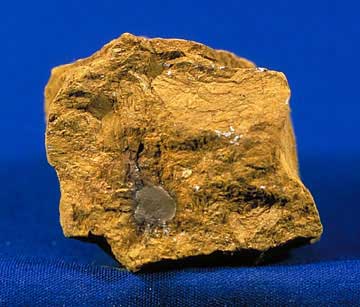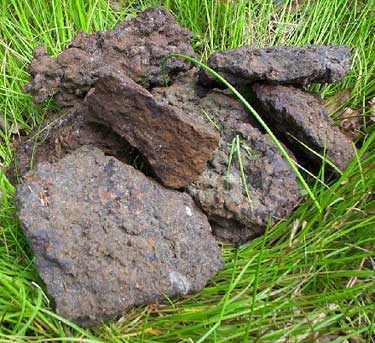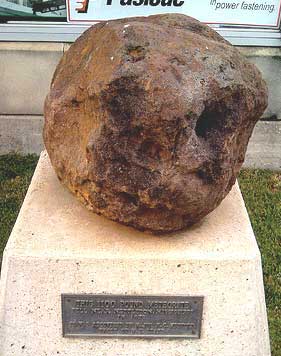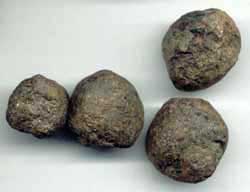limonite
Limonite is an ore consisting in a mixture of hydrated iron(III) oxide-hydroxide of varying composition. The generic formula is frequently written as FeO(OH)·nH2O, although this is not entirely accurate as limonite often contains a varying amount of oxide compared to hydroxide.

LIMONITE
Together with hematite, it has been mined as ore for the production of iron. Limonite is heavy and normally yellowish-brown but can be darker when mixed with iron ore. It is a very common amorphous substance though can be tricky to find when mined with hematite and bog ore.

Bog Iron
Specimen below was found near Rocky Mountain, N.C. in 1935. Owner thought it was a meteorite and tried selling it on eBay. (white specks are paint)

LIMONITE
Together with hematite, it has been mined as ore for the production of iron. Limonite is heavy and normally yellowish-brown but can be darker when mixed with iron ore. It is a very common amorphous substance though can be tricky to find when mined with hematite and bog ore.

Bog Iron
Specimen below was found near Rocky Mountain, N.C. in 1935. Owner thought it was a meteorite and tried selling it on eBay. (white specks are paint)

Elton Jones writes:
On initial look..this does look like a rusty iron in the Campo/CD class however since it broke in half it is obviously not. The Piedmont of The Carolinas and Georgia are common with this kind of material.
Near as I can tell it is a iron cemented (limonite) sand-bearing liner of a a hydro-thermal /vuggy fracture through bedrock within what was either an organic limestone that has completely weathered away leaving the casting--or these are castings from organic material which was buried in loosely consolidated sand. I have found them either way including a few tree branches and fossil cones replaced by this mineral combo. I just found some in Virginia that was so realistic looking that I was sure [ it ] could be a meteorite. The iron content was so high that it rang like an iron and so hard that my hammer left a metallic mark! Apparently sometime in the middle mesozoic there was a sudden rise in oxygen which precipitated iron out of the water. The iron acted like a cement and some of this material is very resistant to breaking. Some on the other hand is very friable and crumbles in one's hand.
I have several samples and some even have relic micro crystals. The limonite can also take the form of red and yellow ocher, which the Indian's powdered and used for pigment.
Regards,
Elton
The specimen here is typical of the shapes that can be found. The Tupelo Meteorite (meteor-wrong) is also a good example.

photo by Nathan Slabaugh
Limonite has been known to form pseudomorphs after other minerals such as pyrite, meaning that the chemical weathering transforms the crystal of pyrite into limonite but keeps the external shape of the pyrite crystal. It has also been formed from other iron oxides, hematite and magnetite; the carbonate siderite and iron rich silicates like some garnets.



